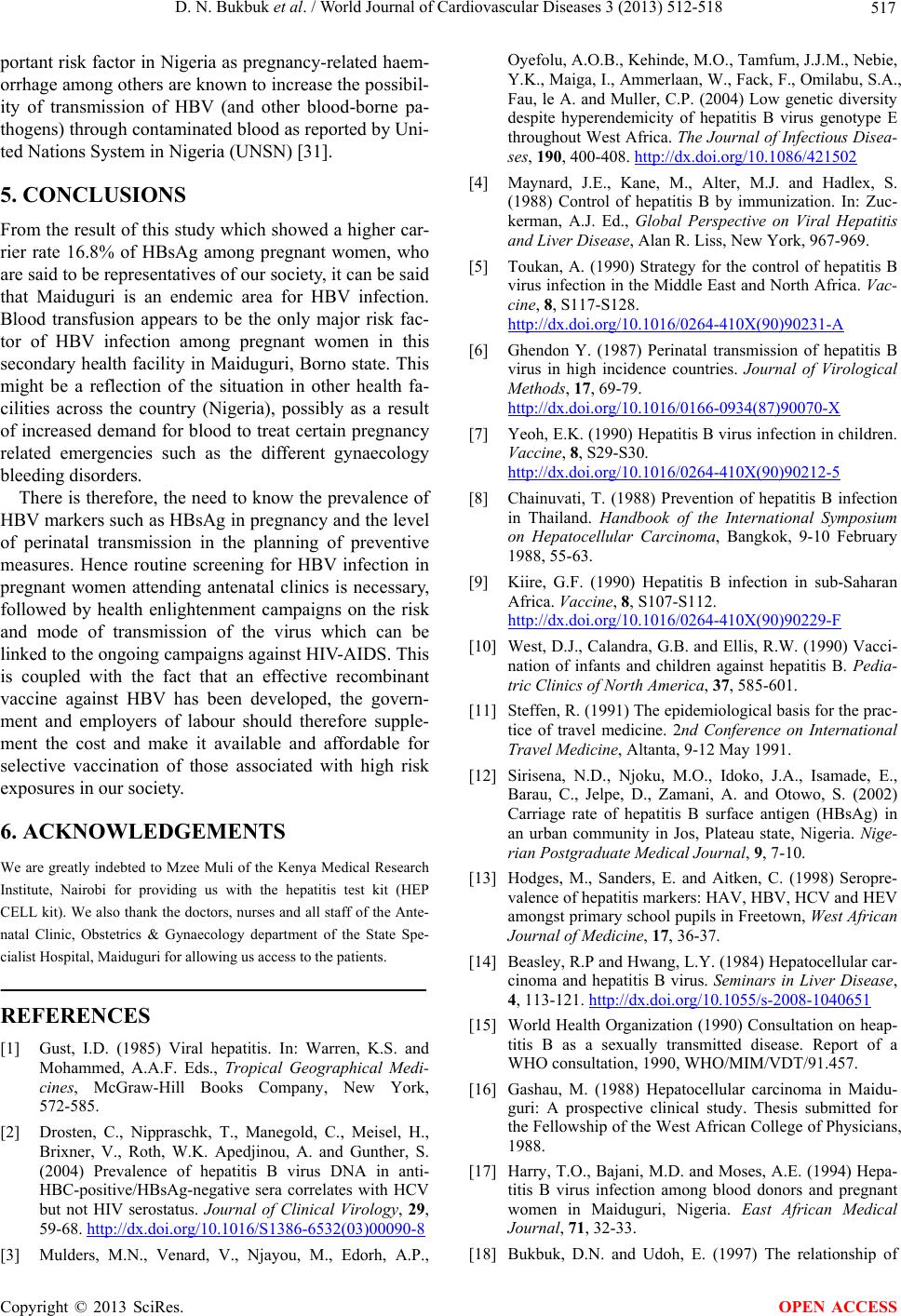
D. N. Bukbuk et al. / World Journal of Cardiovascular Diseases 3 (2013) 512-518 517
portant risk factor in Nigeria as pregnancy-related haem-
orrhage among others are known to increase the possibil-
ity of transmission of HBV (and other blood-borne pa-
thogens) through contaminated blood as reported by Uni-
ted Nations System in Nigeria (UNSN) [31].
5. CONCLUSIONS
From the result of this study which showed a higher car-
rier rate 16.8% of HBsAg among pregnant women, who
are said to be representatives of our society, it can be said
that Maiduguri is an endemic area for HBV infection.
Blood transfusion appears to be the only major risk fac-
tor of HBV infection among pregnant women in this
secondary health facility in Maiduguri, Borno state. This
might be a reflection of the situation in other health fa-
cilities across the country (Nigeria), possibly as a result
of increased demand for blood to treat certain pregnancy
related emergencies such as the different gynaecology
bleeding disorders.
There is therefore, the need to know the prevalence of
HBV markers such as HBsAg in pregnancy and the level
of perinatal transmission in the planning of preventive
measures. Hence routine screening for HBV infection in
pregnant women attending antenatal clinics is necessary,
followed by health enlightenment campaigns on the risk
and mode of transmission of the virus which can be
linked to the ongoing campaigns against HIV-AIDS. This
is coupled with the fact that an effective recombinant
vaccine against HBV has been developed, the govern-
ment and employers of labour should therefore supple-
ment the cost and make it available and affordable for
selective vaccination of those associated with high risk
exposures in our society.
6. ACKNOWLEDGEMENTS
We are greatly indebted to Mzee Muli of the Kenya Medical Research
Institute, Nairobi for providing us with the hepatitis test kit (HEP
CELL kit). We also thank the doctors, nurses and all staff of the Ante-
natal Clinic, Obstetrics & Gynaecology department of the State Spe-
cialist Hospital, Maiduguri for allowing us access to the patients.
REFERENCES
[1] Gust, I.D. (1985) Viral hepatitis. In: Warren, K.S. and
Mohammed, A.A.F. Eds., Tropical Geographical Medi-
cines, McGraw-Hill Books Company, New York,
572-585.
[2] Drosten, C., Nippraschk, T., Manegold, C., Meisel, H.,
Brixner, V., Roth, W.K. Apedjinou, A. and Gunther, S.
(2004) Prevalence of hepatitis B virus DNA in anti-
HBC-positive/HBsAg-negative sera correlates with HCV
but not HIV serostatus. Journal of Clinical Virology, 29,
59-68. http://dx.doi.org/10.1016/S1386-6532(03)00090-8
[3] Mulders, M.N., Venard, V., Njayou, M., Edorh, A.P.,
Oyefolu, A.O.B., Kehinde, M.O., Tamfum, J.J.M., Nebie,
Y.K., Maiga, I., Ammerlaan, W., Fack, F., Omilabu, S.A.,
Fau, le A. and Muller, C.P. (2004) Low genetic diversity
despite hyperendemicity of hepatitis B virus genotype E
throughout West Africa. The Journal of Infectious Disea-
ses, 190, 400-408. http://dx.doi.org/10.1086/421502
[4] Maynard, J.E., Kane, M., Alter, M.J. and Hadlex, S.
(1988) Control of hepatitis B by immunization. In: Zuc-
kerman, A.J. Ed., Global Perspective on Viral Hepatitis
and Liver Disease, Alan R. Liss, New York, 967-969.
[5] Toukan, A. (1990) Strategy for the control of hepatitis B
virus infection in the Middle East and North Africa. Vac-
cine, 8, S117-S128.
http://dx.doi.org/10.1016/0264-410X(90)90231-A
[6] Ghendon Y. (1987) Perinatal transmission of hepatitis B
virus in high incidence countries. Journal of Virological
Methods, 17, 69-79.
http://dx.doi.org/10.1016/0166-0934(87)90070-X
[7] Yeoh, E.K. (1990) Hepatitis B virus infection in children.
Vaccine, 8, S29-S30.
http://dx.doi.org/10.1016/0264-410X(90)90212-5
[8] Chainuvati, T. (1988) Prevention of hepatitis B infection
in Thailand. Handbook of the International Symposium
on Hepatocellular Carcinoma, Bangkok, 9-10 February
1988, 55-63.
[9] Kiire, G.F. (1990) Hepatitis B infection in sub-Saharan
Africa. Vaccine, 8, S107-S112.
http://dx.doi.org/10.1016/0264-410X(90)90229-F
[10] West, D.J., Calandra, G.B. and Ellis, R.W. (1990) Vacci-
nation of infants and children against hepatitis B. Pedia-
tric Clinics of North America, 37, 585-601.
[11] Steffen, R. (1991) The epidemiological basis for the prac-
tice of travel medicine. 2nd Conference on International
Travel Medicine, Altanta, 9-12 May 1991.
[12] Sirisena, N.D., Njoku, M.O., Idoko, J.A., Isamade, E.,
Barau, C., Jelpe, D., Zamani, A. and Otowo, S. (2002)
Carriage rate of hepatitis B surface antigen (HBsAg) in
an urban community in Jos, Plateau state, Nigeria. Nige-
rian Postgraduate Medical Journal, 9, 7-10.
[13] Hodges, M., Sanders, E. and Aitken, C. (1998) Seropre-
valence of hepatitis markers: HAV, HBV, HCV and HEV
amongst primary school pupils in Freetown, West African
Journal of Medicine, 17, 36-37.
[14] Beasley, R.P and Hwang, L.Y. (1984) Hepatocellular car-
cinoma and hepatitis B virus. Seminars in Liver Disease,
4, 113-121. http://dx.doi.org/10.1055/s-2008-1040651
[15] World Health Organization (1990) Consultation on heap-
titis B as a sexually transmitted disease. Report of a
WHO consultation, 1990, WHO/MIM/VDT/91.457.
[16] Gashau, M. (1988) Hepatocellular carcinoma in Maidu-
guri: A prospective clinical study. Thesis submitted for
the Fellowship of the West African College of Physicians,
1988.
[17] Harry, T.O., Bajani, M.D. and Moses, A.E. (1994) Hepa-
titis B virus infection among blood donors and pregnant
women in Maiduguri, Nigeria. East African Medical
Journal, 71, 32-33.
[18] Bukbuk, D.N. and Udoh, E. (1997) The relationship of
Copyright © 2013 SciRes. OPEN ACCESS